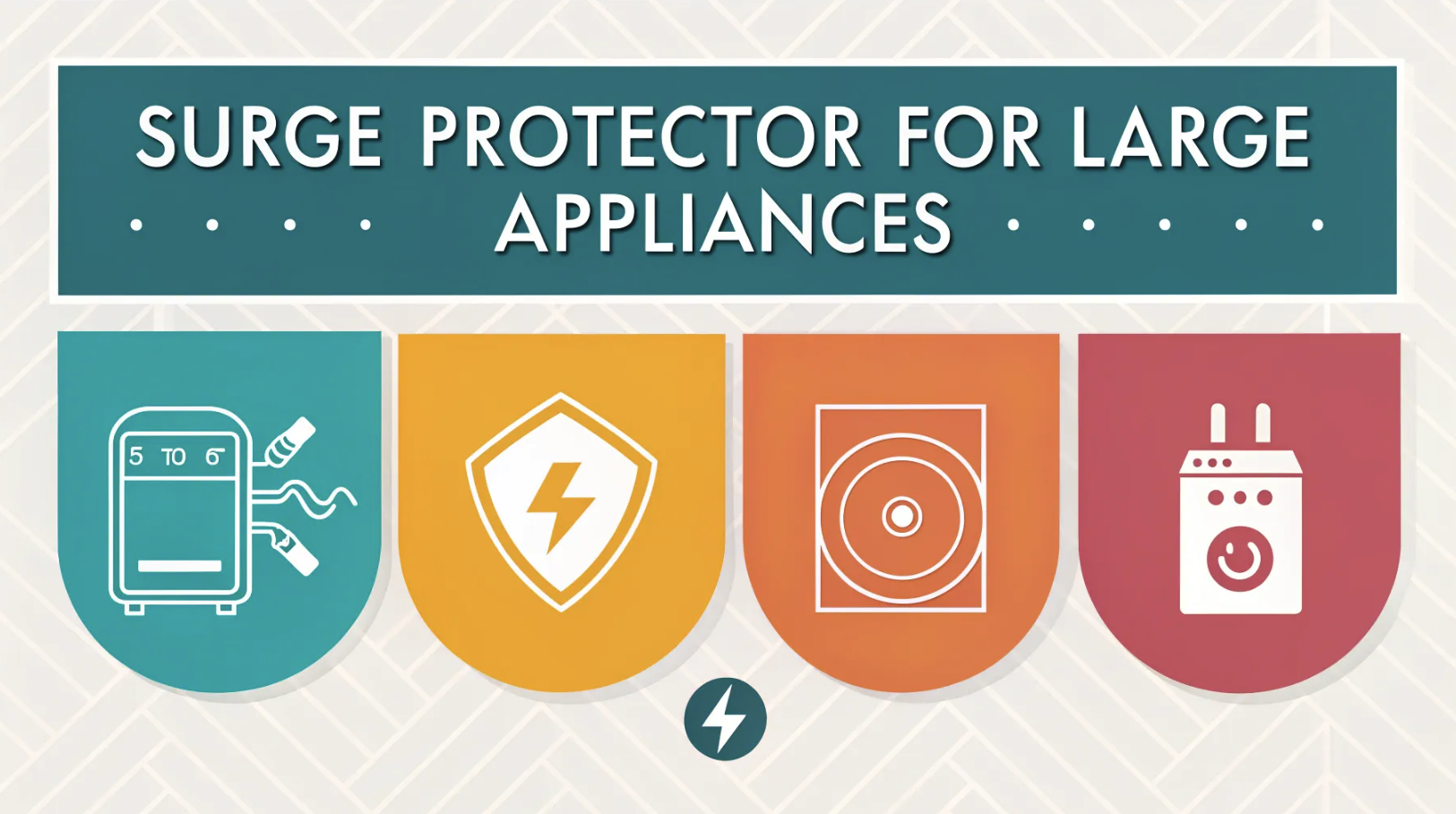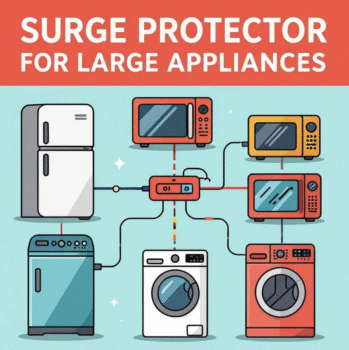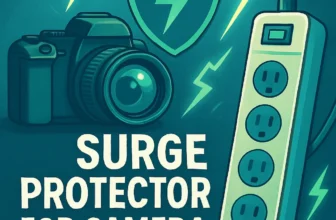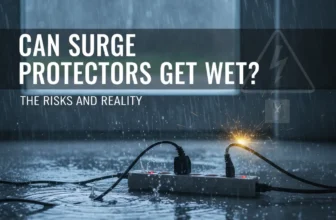Published By: Sean Hudson | Last updated on May 30, 2025 and reviewed by Editorial Team

Power surges can wreak havoc on your home’s most essential appliances. Imagine hearing a sudden pop, smelling something burning, and realizing your refrigerator or dishwasher is fried. That’s the reality many face when their unprotected appliances encounter a surge. These voltage spikes could overload circuits, damage their internal components and usually lead to costly repairs or replacements.
A surge protector for large appliances acts as a shield ️, absorbing excess electricity and ensuring your appliances stay safe. Investing in surge protection isn’t just about saving money—it’s about peace of mind and the safety of your home.
In this article, I will provide a list of appliances vulnerable to power surges and recommend one that suits your needs.
Understanding Power Surges and Their Impact
What Are Power Surges?
A power surge happens when the flow of electricity spikes beyond the standard voltage level. Think of it as a sudden wave of energy rushing through your home’s electrical system. This spike can last for less than a second, but its effects can be devastating. Surges often occur due to external factors like lightning strikes or issues with the power grid.
For example, when lightning hits nearby, it can send overwhelming electricity into your home. Even something as simple as turning on a high-powered appliance can cause a smaller, internal surge.
These surges create an arc of electrical current, which generates heat. That heat stresses the wiring and components inside your appliances. This heat can damage sensitive electronics without proper surge protection, resulting in costly repairs or replacements. While power surges don’t happen every day, they’re highly unpredictable. That’s why a surge protector is essential for keeping your appliances safe.
Why Are Power Surges Harmful to Large Appliances?
Large appliances like refrigerators, washing machines, and air conditioners are particularly vulnerable to power surges. These devices rely on complex internal systems, including microprocessors, to function. When a surge occurs, the excess electricity overloads these systems. This can fry the circuits, ruin the wiring, or even cause the appliance to stop working entirely.
The damage doesn’t just stop at functionality. Power surges also shorten the lifespan of your appliances. Each surge adds stress to their components, causing wear and tear over time. For instance, a refrigerator exposed to repeated surges might start malfunctioning years before it should. Replacing or repairing these appliances can cost hundreds, if not thousands, of dollars. Surge protection acts as a barrier, absorbing the excess energy and preventing it from reaching your appliances.
It’s important to note that not all surges come from outside your home. Internal surges, caused by high-powered devices cycling on and off, can also harm your appliances. For example, when your air conditioner kicks on, it can create a small surge that affects other devices on the same circuit. A surge protector ensures that these minor spikes don’t accumulate into major damage over time.
Appliances Most Vulnerable to Power Surges
Power surges don’t discriminate, but some appliances are more at risk than others. These devices often have sensitive electronic components or high power demands, making them prime targets for damage.
Let’s find out which appliances need extra protection and why.
Large Appliances That Require a Surge Protector
Certain large appliances in your home are particularly vulnerable to power surges. Here’s a quick rundown of the ones that benefit most from a surge protector:
-
Refrigerators and Freezers: These appliances rely on electronic control systems to regulate temperature and manage their compressors. A surge can fry these systems, leaving you with spoiled food and costly repairs. Using surge protectors for refrigerators is a smart move to avoid such headaches.
-
Microwaves: Microwaves have intricate timing and control systems. A sudden voltage spike can damage these components, turning your microwave into an expensive paperweight.
-
Dishwashers and Washing Machines: Modern dishwashers and washing machines often include digital displays and programmable settings. These features make them convenient but also more susceptible to surge-related damage.
-
Air Conditioners: Air conditioners draw significant power, especially when cycling on and off. This makes them both a source of internal surges and a victim of external ones.
-
Smart Appliances: Devices like smart refrigerators or programmable coffee makers store digital information. A surge can wipe out stored data, forcing you to reprogram or even replace the appliance.
Why These Appliances Are at Risk
Due to their design and functionality, large appliances are particularly vulnerable to power surges. Let me explain why these devices are so vulnerable:
-
Sensitive Electronics: Many modern appliances include microprocessors and integrated circuits. These components handle everything from temperature control to digital displays. Even a small surge can overwhelm these delicate parts, leading to malfunctions or complete failure.
-
High Power Usage: Appliances like air conditioners and refrigerators consume a lot of electricity. When they cycle on and off, they can create internal surges that affect other devices on the same circuit. Without a surge protector, these spikes can cause gradual wear and tear.
-
Expensive Repairs: Replacing or repairing large appliances isn’t cheap. A damaged compressor in a refrigerator or a fried control panel in a dishwasher can cost hundreds of dollars. Surge protectors act as a shield, absorbing excess energy and sparing you from these expenses.
-
Frequent Exposure: Appliances plugged in 24/7, like refrigerators and freezers, are constantly exposed to potential surges. This makes them more likely to experience cumulative damage over time.
Investing in a surge protector for these appliances isn’t just about avoiding inconvenience. It’s about protecting your home, your wallet, and your peace of mind. Whether it’s a whole-house surge protector or individual units, taking this step ensures your appliances stay safe and functional for years to come.
Choosing the Right Surge Protector for Large Appliances
Not all surge protectors are created equal when it comes to protecting your large appliances. Choosing the right one can make a difference in ensuring your devices’ safety and longevity. Let’s break down what you need to know.
Key Features to Look For in a Surge Protector
Not every surge protector offers the same level of protection. Some are better suited for small electronics, while others are designed specifically for heavy-duty appliances. Here’s what to look for:
-
Joule Rating: The joule rating tells you how much energy the surge protector can absorb before it fails. For large appliances, aim for a rating of at least 900 joules. High-end models like Belkin and GE come with ratings between 3000 and 5000 joules provide even better protection capabilities.
-
Clamping Voltage: This is the voltage level at which the surge protector starts to work. Lower clamping voltages (around 400 volts or less) are ideal for sensitive appliances like refrigerators and dishwashers.
-
Response Time: A fast response time ensures the surge protector reacts quickly to voltage spikes. Look for models with a response time of less than one nanosecond.
-
UL Certification: Always check for UL (Underwriters Laboratories) certification. This guarantees the surge protector meets safety standards and has been tested for reliability.
-
Dedicated Outlets: Some surge protectors come with outlets specifically designed for large appliances. These outlets can handle higher power demands without compromising safety.
When you’re shopping, keep these features in mind. They’ll help you find a surge protector that matches your appliance’s needs and provides the best protection capabilities.
Recommended Surge Protectors for Large Appliances
Finding the right surge protector for large appliances doesn’t have to be overwhelming. Here are some top recommendations that balance performance, safety, and affordability:
-
Tripp Lite Isobar Surge Protector: Known for its high joule rating and durable design, this model is perfect for refrigerators and air conditioners. It also includes noise filtering, which can improve appliance performance.
-
Belkin 12-Outlet Surge Protector: With a joule rating of 3940, this surge suppressor offers excellent protection for multiple appliances. Its slim design makes it easy to fit behind large devices.
-
APC SurgeArrest Performance: This model provides up to 3400 joules of surge protection and includes indicator lights to show when it’s working properly. It’s a great choice for washing machines and dishwashers.
-
Leviton Whole-House Surge Protector: For comprehensive protection, consider a whole-house surge protector. This device safeguards your entire electrical system, including all large appliances.
Each of these options has been thoroughly tested for reliability and offers features specifically designed for large appliances. Choose one that fits your budget and meets your specific needs.
Installation Tips for Surge Protectors
Installing a surge protector might seem intimidating, but it’s simpler than you think. Follow these tips to ensure proper setup and maximum safety:
-
Read the Manual: Every surge protector comes with instructions. Take a few minutes to read them before you start.
-
Plug Directly into the Wall: For large appliances, always plug the surge protector directly into a wall outlet. Avoid using extension cords, as they can reduce the effectiveness of surge protection.
-
Position Strategically: Place the surge protector in a location where it won’t be exposed to moisture or extreme heat. This helps maintain its performance over time.
-
Check the Load Capacity: Make sure the surge protector can handle the power requirements of your appliance. Overloading it can lead to failure.
-
Test Regularly: Some surge protectors include indicator lights to show they’re working. Check these lights periodically to ensure your appliances remain protected.
If you’re unsure about installation, consult a professional electrician. They can help you set up a surge protector or even install a whole-house surge suppressor for added peace of mind.
Large appliances play a vital role in our daily routines, but they face constant threats from power surges. A single surge can cause irreversible damage, resulting in costly repairs or replacements. Investing in surge protection is a smart and proactive step. Whether you choose a dedicated surge protector for each appliance or a whole-home solution, you’re safeguarding your appliances and your wallet.
Surge protection doesn’t just prevent damage—it extends the lifespan of your devices and ensures they operate efficiently. Take action today to protect your home and enjoy peace of mind.








